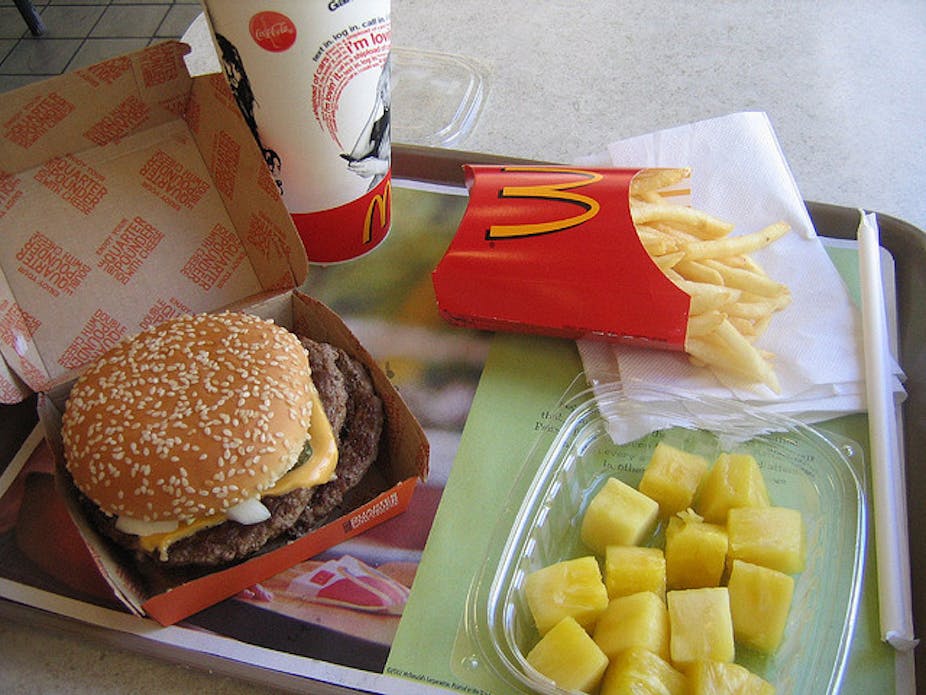
The Heart Foundation today announced plans to dump its tick from takeaway foods, citing unfair advantage for companies such as McDonalds over small takeaway outlets that can’t afford the accreditation fees.
The tick will still be available to supermarket food manufacturers.
So what does the tick actually mean? And does it improve consumer decisions? Professor Sandra Jones, the Director of the Centre for Health Initiatives at the University of Wollongong, explains:
The Heart Foundation tick is perceived by consumers to mean a product is healthy. But it’s more complicated than that.
The tick means a product is healthier than other options but it doesn’t mean it’s healthy in its own right.
A meat pie, for example, can get a tick if it’s lower in fat and salt than other meat pies, but it doesn’t mean this is a healthy food that should be chosen over a salad.
How is the tick awarded?
The manufacturer applies to the Heart Foundation and is awarded the tick if they demonstrate that particular food product meets nutritional standards.
There’s a fee charged but it’s not about buying the tick; it’s based on cost recovery. The idea is that the fee covers the Heart Foundation’s work in assessing the food, monitoring the food and making sure it meets the standards.
What role does the tick play in encouraging food manufacturers to reduce the salt, fat and sugar contents of their foods?
There is a motivation – if you want to earn the tick – to modify your foods to meet the guidelines. That’s a very definite positive. Fast food outlets that wanted to earn the tick have reduced the fat, salt and sugar content of some of their products.
But the difficulty comes when we see what’s called the “halo effect”. If a fast food outlet serves 50 products and three of them have the Heart Foundation tick, the outlet could promote itself as providing healthy foods.
These three products may well be healthy, or at least healthier than other options. But once a consumer goes into a store, they won’t necessarily choose the healthy option. Overall the outlet seems healthy because it has that tick.
How does the tick affect food prices? Do people choose more expensive tick products they think are healthier?
Like other such programs, you have to meet the standards to obtain a tick and you’ve got to have the financial resources and motivation to participate in the program.
So there’s a real possibility that cheaper and healthier foods are available that don’t have the tick because the manufacturer hasn’t applied for accreditation.
But studies suggest that when people buy foods, price is the biggest consideration. If something is expensive, even if it’s slightly healthier, a large proportion of consumers will still purchase the cheaper product.
What do you make of the Heart Foundation’s plan to remove the tick from takeaway foods?
They’re moving away from ticks on takeaway foods because they want to focus on ingredients – the things that go into stores and restaurants that drive the actual product.
If we’ve got good ingredients going in to food outlets, then we should see an increase in the healthiness of food.
Removing the tick on takeaway foods should have a positive impact on the Heart Foundation’s credibility.
There was a huge outcry from consumers, public health experts and the media when the tick was given to McDonalds. The view was that the tick must be up for sale if it’s going to places that serve such unhealthy foods.
This severely dented the Heart Foundation’s credibility and made people wonder what the tick actually meant.
Does the tick need to be remodelled to become more effective?
There are some issues with the tick, just as there are issues with any kind of program that provides credentials.
And with any food labelling or nutrition program, we need to consider the way consumers interpret and use the information – just because this food has a tick doesn’t mean it’s the best thing to eat.
But changing our food supply and our approach to different types of food is a long-term challenge.
The way we make foods taste nice is by putting fat or salt or sugar in them. And if you take all of those things away, with the exception of fresh fruit and vegetables, a lot of foods don’t taste as nice.
Is it possible for public health organisations to have a positive relationship with the food industry and still achieve their goals?
It’s always tricky because the food industry’s job is to sell food and produce a profit and there’s going to be some contradiction between those two things.
The healthiest foods may not be the cheapest to produce and they may not be the easiest to sell, given consumers’ taste preferences.
It’s possible to work together but we have to set very clear limits about what we want from the food industry and ensure standards are maintained.
We also have to be realistic – we can’t tell fast food outlets to stop selling burgers and chips, and just sell salads.
How can food labels be improved?
We need to move towards an Australia-wide system of much clearer labelling of food.
We need to remove deceptive words such as light and low fat and move towards clear packaging. A traffic light labelling system could easily show consumers whether a particular product was high, low, or medium in salt, fat and sugar.
If we want people to make healthy food choices, we have to provide them with clear objectives and easy-to-understand information.

